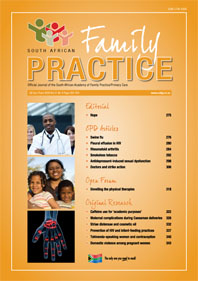Smokeless Tobacco: Is It Really Safe?
Keywords:
smokeless tobacco, cardiovascualr risks, health implications, snuff
Abstract
Antismoking campaigns and government legislation have resulted in a decline in smoking. However, the use of smokeless tobacco (SLT) is on the increase. Smokeless tobacco is non-smoked tobacco used either intranasally or intraorally. The increase in its use is possibly due to the perception that SLT is a safe alternative to smoking. SLT includes tobacco products such as snuff (sniffed or placed in the oral cavity) and tobacco leaves (which are chewed). In South Africa, traditional and social practices influence SLT use. While the adverse health outcomes associated with smoking are well established, some health risks attributable to SLT use have not been studied conclusively, especially those that affect the cardiovascular system. Although some studies have found some relationships between SLT use and adverse health outcomes, others have found SLT use to be associated with risks not higher than those in non-users. This article reviews the available literature on the use of SLT, the associated health risks and adverse health outcomes with the aim of providing a scientific basis on which primary care physicians can make rational decisions when confronted with current SLT users or those who contemplate using SLT as a nicotine harm-reduction substance.
Published
2009-05-16
Section
CPD
By submitting manuscripts to SAFP, authors of original articles are assigning copyright to the South African Academy of Family Physicians. Copyright of review articles are assigned to the Publisher, Medpharm Publications (Pty) Ltd, unless otherwise specified. Authors may use their own work after publication without written permission, provided they acknowledge the original source. Individuals and academic institutions may freely copy and distribute articles published in SAFP for educational and research purposes without obtaining permission.

